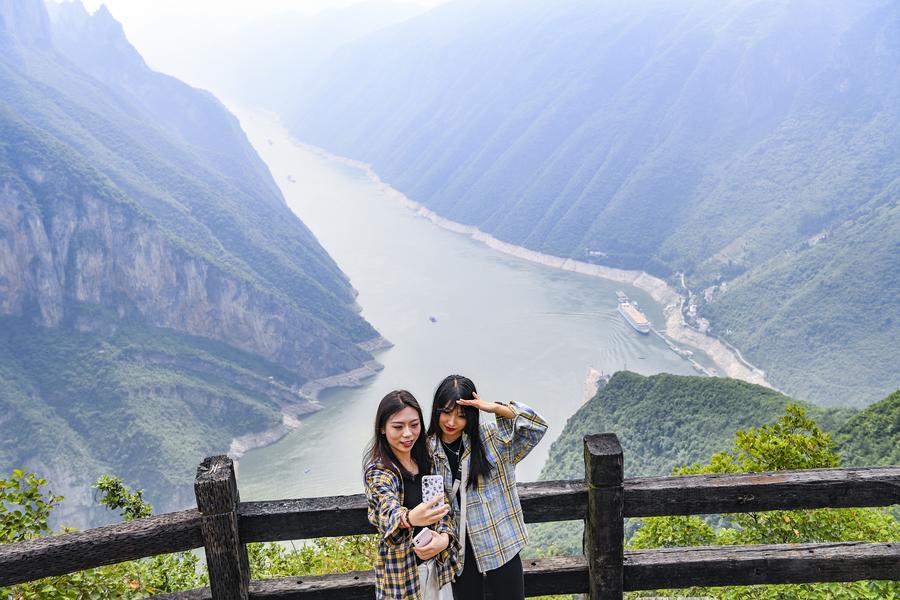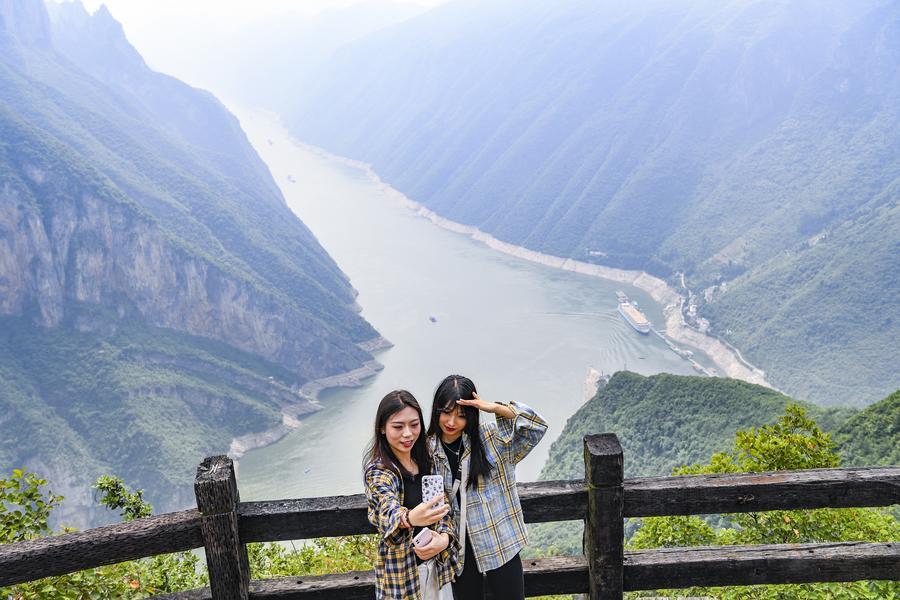
Tourists pose for photos at a scenic area in Wushan County, southwest China's Chongqing Municipality, May 16, 2024. (Xinhua/Wang Quanchao)
BEIJING, May 23 (Xinhua) -- From characteristic tourism of local uniqueness, to technology-enabled smart tourism and new fashionable Chinese-style tourism, China's cultural tourism industry has attained new heights through integrated development in recent years, with new business forms mushrooming.
In China, tourism industry has turned out to be a new pillar industry with strategic significance and an industry with distinctive characteristics of the times for people's livelihood and happiness.
Statistics show that from 2012 to 2021, China's domestic tourism revenue had an average annual growth rate of about 10.6 percent; from 2012 to 2019, the number of domestic tourist trips doubled, and the figure reached 4.891 billion in 2023, bringing a total consumption of 4.91 trillion yuan. In the first quarter of 2024, the total consumption of domestic tourism trips amounted to 1.52 trillion yuan with a year-on-year increase of 17.0 percent, playing a prominent role in increasing consumption and promoting domestic demand.
China has formed the largest domestic tourism market in the world as well as the biggest source and a major destination of international tourism.
Innovation is the prime driver of tourism development. Various regions in China keep exploring their own tourism resources with local characteristics and developing new tourism themes, so as to create more "golden signboards" of local tourism.
Tourists flood into Zibo City in east China's Shandong Province and Tianshui City in northwest China's Gansu Province for special kebab and malatang (mini spicy hot pot), highlighting the effect of "influencer economy". Guiding visitors to taste local delicacies, appreciate scenic spots and experience culture, the two cities provide premium services to build city brands and develop the new model of "gastronomic tourism". On the occasion of the launch of the Chang'e 6 lunar probe, Wenchang in south China's Hainan Province develops "aerospace tourism" at a faster pace to attract a huge flow of tourists to watch the launch of rocket. At the same time, the city keeps innovating aerospace-related products and artistic programs, allowing visitors to appreciate the charm of China's aerospace industry.
Industrial insiders noted that the new business forms and approaches of developing cultural tourism industry are unleashing consumption potential.
At the beginning of this year, the culture and tourism authority launched the first batch of 42 national pilot projects for developing immersive smart tourism experience spaces. These projects combine traditional cultural tourism spaces with digital technology and cultural and creative elements to allow profound tourist engagement and interaction, thus forming new tourism products and new consumption scenarios.
Examples include the 5G Grand Canal immersive experience zone at the China Grand Canal Museum in Yangzhou, east China’s Jiangsu Province, the "A Dreamlike Time Travel to Tang Dynasty" metaverse experience at the Nianhua Bay in Wuxi, Jiangsu Province and the immersive night tour at the Nishan Sacred Land scenic spot in Shandong Province. New business forms of smart tourism like cloud-based tourism, entertainment and exhibition are empowered by science and technology, and new industrial transformation is taking place through deep integration of digital technology and tourism.
At present, technologies like mobile Internet, big data and AI get more deeply integrated with various tourism scenarios to enable the industrial transformation and upgrading for higher quality, said Wang Jinwei, professor at Beijing International Studies University, adding that as people's consumption needs become diversified, the new business forms of cultural tourism empowered by digital technologies are increasingly welcomed by consumers, and serving as a digital engine for the development of cultural tourism industry.
The integrated cultural tourism development is going deeper, represented by the addition of more diverse elements like China-chic.
Visitors stroll in the Great Tang All Day Mall, dressed in the Han-style clothing, tick off the Nanyue Great Temple in the list with head-pinned flowers, and appreciate the wall of Chinese roses at Renfengli, holding traditional lacquer fans "Slow in Yangzhou"… China's tourism business ushers in new trend of Chinese-chic.
The new tourism models combining historical and cultural heritage, charm of ancient customs and folk culture are being widely known, which witnessed a boom of consumption in the latest May Day holiday.
During the holiday period, the monitored national night culture and tourism consumption agglomeration zones reported a total of 72.5758 million nighttime visitors, a year-on-year increase of 6.9 percent on comparable basis.
Data from Tongcheng Travel, a tourism platform, showed that during the May Day holiday, the booking volume of popular museums and ancient cities and villages had a four-fold increase compared with the same period of last year.
Since the tourism market gets more diversified, tourists are no longer satisfied with the traditional superficial sightseeing and photo-taking patterns. Instead, they pay more attention to tourism experience and quality to see if tourism products contain sufficient cultural content, Wang said.
According to Wang, as its deepening integration with other industries, tourism industry has been playing a more significant role in driving economic and social development, and is expected to be a pillar industry serving people's better life. (Edited by Yang Yifan with Xinhua Silk Road, yangyifan@xinhua.org)




 A single purchase
A single purchase









